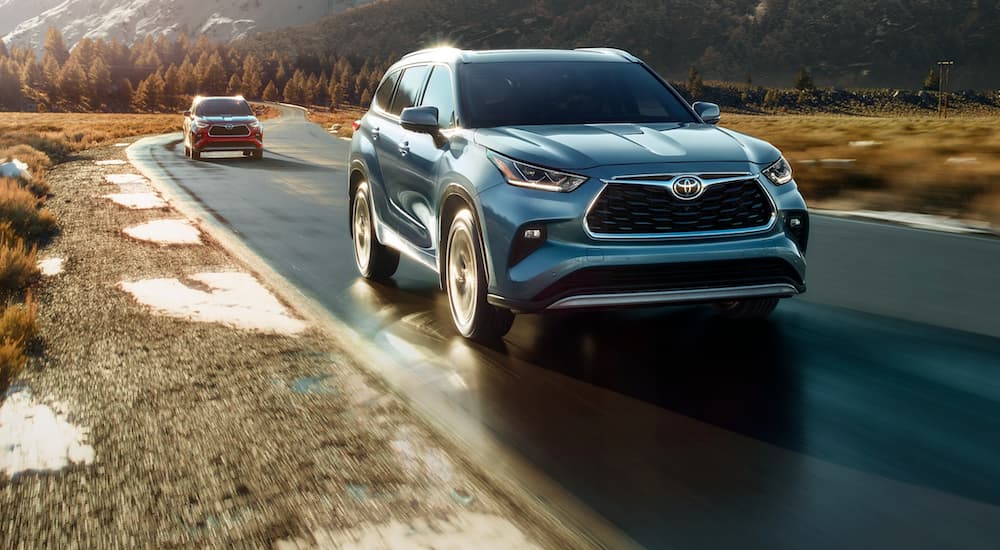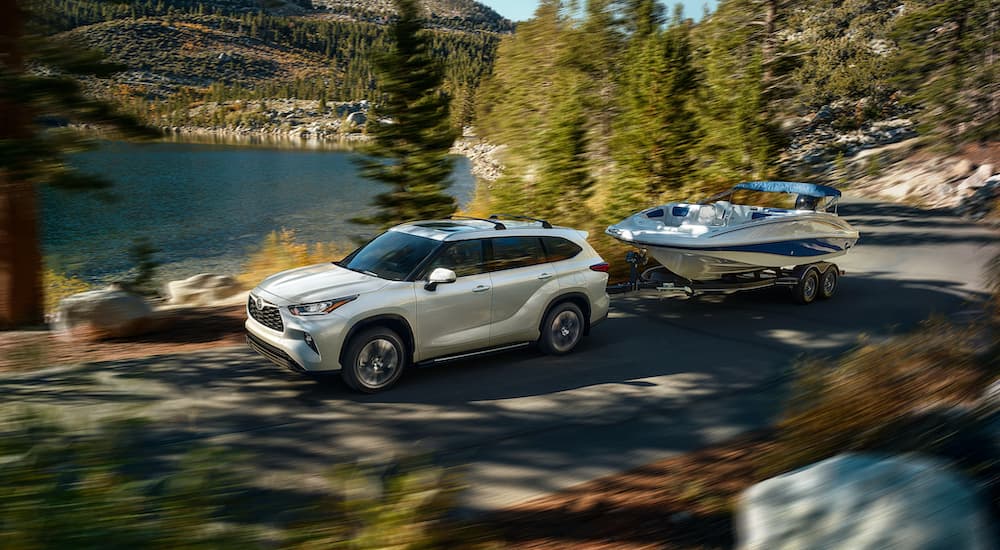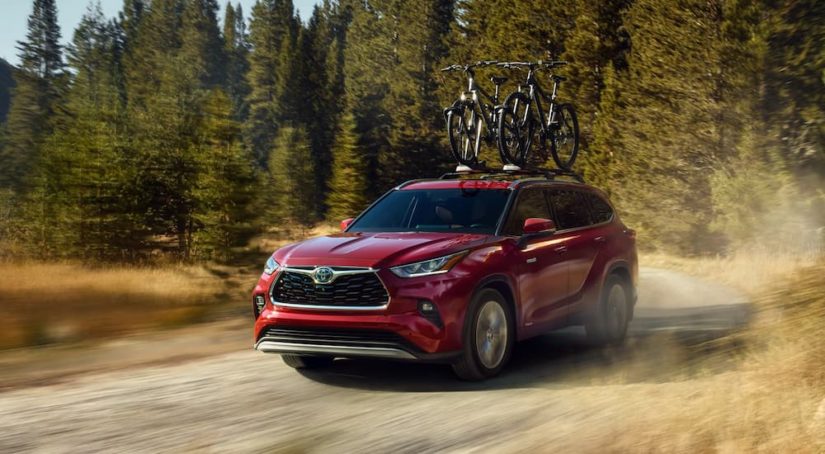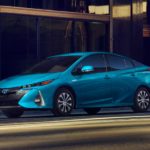The 2022 Toyota Highlander is a stylish midsize SUV that stands out as being a visually enticing and spacious family-oriented vehicle without sacrificing much in the power and performance department. However, the Hybrid version of the vehicle does give up some horsepower and torque in favor of fuel savings. Obviously, for those weighing which version of the midsize SUV is worth it, asking yourself, “Should I buy a standard 2022 Toyota Highlander or a 2022 Toyota Highlander Hybrid?” is going to be an important step. That’s why we are here to run through the pros and cons of going standard combustion versus hybrid and discuss what your total costs and savings will be going with either version of the popular Toyota SUV.
Standard Highlander vs Highlander Hybrid Trim Availability
The standard 2022 Toyota Highlander is available in seven different trim formats: the base L trim, the LE trim, the XLE trim, the XSE, the Bronze Edition, the Limited, and finally, the Platinum. You can also get the Highlander in a hybrid version of select trims, including the Hybrid LE, the Hybrid XLE, the Hybrid Limited, and the Hybrid Platinum. Right from the start, you can see that there is a limitation on the availability of the hybrid iterations of the Highlander versus the standard combustion configurations. That does limit the scalability of some features (or price ranges) that the Toyota Highlander Hybrid fits into. Essentially it means you won’t be able to get the Highlander Hybrid in L or Bronze Edition trims.

Cost Differences Between a Standard 2022 Highlander and a Highlander Hybrid
Limited availability of trim formats for the Highlander Hybrid can alter how you budget for SUV shopping. For instance, the L trim, which has an MSRP that starts at $35,855, is not available in a hybrid format, which means you’re missing out on those savings with the Highlander Hybrid, which starts at the LE trim. The LE trim has a starting MSRP of $38,055, which is a $2,200 price difference between the base Highlander and the LE. Also, keep in mind that those are the price differences for the internal combustion engine version of the Highlander, not the Highlander Hybrid.
All Highlander Hybrid trims cost roughly $1,500 more than their combustion engine counterparts from the start. So, for the base Toyota Highlander Hybrid, you’ll be paying $39,555. Obviously, the question becomes, is the higher pricing a deal-breaker?
All of that is entirely dependent on your budget. However, you also need to consider an essential aspect of choosing between a standard combustion engine and a hybrid: longevity and maintenance costs. Just because you buy a vehicle and pay less for it than another trim or configuration doesn’t necessarily mean that it will give you more for your money in the long run. Remember, the big selling point with the hybrid is the fuel-saving you get with the vehicle.
How much do you save on fuel with a hybrid Highlander? Well, you get an average of 21 miles per gallon in the city and up to 29 miles per gallon on the highway with the standard Highlander. Meanwhile, the Highlander Hybrid nets you 36 miles per gallon in the city and up to 35 miles per gallon on the highway, which averages out to 38% more travel distance in the city with the Highlander Hybrid before having to refuel compared to the standard Highlander.
Fuel Costs and Savings
While the upfront $1,500 more for the Highlander Hybrid in any comparable trim might seem expensive, you do have to consider what the overall savings would be at the pump. With a 17-gallon tank, it means driving in the city with a standard Highlander will net you about 357 miles or so before you have to refuel. Over the span of 100,000 miles, it means you’ll be making approximately 280 trips to the gas station, give or take.
With the Highlander Hybrid, you can travel about 612 miles in the city on a full tank before having to refuel. Over the course of 100,000 miles traveling in the city, you’re looking at having to make about 163 trips to the gas station. In short, that means you’ll be making about 42% fewer trips to the pump per 100,000 miles with the Highlander Hybrid compared to the standard Highlander.
If you value your dollar and you overall don’t like spending lots of money at the gas pump, there’s really no denying just how much you will be saving in the long run if you opt for a Toyota Highlander Hybrid. Also, keep in mind that the cost of fuel goes up for all-wheel drive configurations of the Highlander in standard combustion format because you get less overall gas mileage out of the all-wheel drive. In fact, the all-wheel drive drops down to 20 miles per gallon in the city and 27 miles per gallon on the highway. Meanwhile, the Highlander Hybrid’s all-wheel drive tops out at 35 miles per gallon in the city and 35 miles per gallon on the highway. So even if you opt for the all-wheel drive, you’re still saving nearly half at the pump due to far fewer visits compared to the standard Highlander.

Repair Costs and Longevity
Average maintenance costs will be about the same for both vehicles in terms of getting the oil changed and rotating the tires or getting alignments done. However, in terms of longevity, there is a stark difference in terms of which one will give you more bang for your buck in the long run. The standard Highlander runs on a gasoline-powered 3.5-liter V6. With the hybrid powertrain, you get a 2.5-liter 4-cylinder paired with an electric motor. So there is a different level of wear and tear that both systems will go through. With the 3.5-liter V6, you get more overall power to the pedal at 295 horses and 263 pound-feet of torque, whereas with the hybrid 2.5-liter 4-cylinder, you get 243 horsepower and 175 pound-feet of torque.
While you’re giving up some obvious power gains between the hybrid and standard Highlander, it is interesting to note that according to an iSeeCars study, the Toyota Highlander Hybrid made it into the top 15 list of some of the longest-lasting vehicles to reach 200,000 miles. More specifically, only 1.2% of the standard Toyota Highlander SUVs made it to the 200,000-mile mark, whereas 3.8% of the Toyota Highlander Hybrid SUVs made it past the 200,000-mile mark. That’s an impressive difference based on upkeep and maintenance. Essentially, if you can keep your Highlander Hybrid well maintained, then you shouldn’t have any issues keeping it on the road on average for longer than the standard Highlander. Either way, it’s all a numbers game based on what you want, what you want to save now versus what you want to save down the road, as well as how much you’re willing to spend on upkeep.
Hybrid or Non-Hybrid?
If you have the ability to pay the upfront costs, the hybrid version is worth it for the fuel-saving gains down the road. However, if you feel like you’re only going to be driving a 2022 Toyota Highlander for a short while – maybe due to a lease or trading it up for something else within a couple of years – it might be better to opt for a traditional gasoline engine. Nevertheless, it’s all going to boil down to your budget, whether you’re willing to give up a bit of power for fuel economy, and how long you plan on driving your Highlander.



